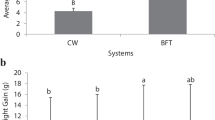Abstract
Separate and combined action of temperature, pH, and heavy metals (copper and zinc) upon whole body activities of casein-and hemoglobinlytic proteinases were studied in perch (Perca fluviatilis), ruff (Gymnocephalus cernuus), roach (Rutilus rutilus), kilka (Clupeonella cultriventris), and common carp (Cyprinus carpio). Also, these activities were determined in cyprinids’ underyearlings (in sum) dominating the food of typical and facultative piscivores. It was revealed that, following a decrease in temperature to 0°C and in the presence of heavy metals (copper and zinc) at concentrations of 10 mg/l, casein-and hemoglobinlytic proteinase activities decreased statistically significantly in all studied fish. Both decrease and increase in pH values lead to less pronounced changes in the enzymatic activities varied in different species. As a rule, decrease in pH values resulted in considerable increase of the hemoglobinlytic activity, while pH increase caused inconsiderable enzyme activation. Combined action of natural factors and, in some cases, combined action of low temperature and metals, changed the caseinlytic activity to a greater extent than at their separate actions. Magnitude of multifactor effects in most cases is lower than of bifactor effects of temperature and metals.
Similar content being viewed by others
References
M. Anson, “The Estimation of Pepsin, Trypsin, Papain and Cathespin with Hemoglobin,” J. Gen. Phys. 22, 79–83 (1938).
V. K. Antonov, Chemistry of Proteolysis (Nauka, Moscow, 1983) [in Russian].
E. A. Bendiksen, O. K. Berg, M. Jobling, et al., “Digestibility, Growth and Nutrient Utilization of Atlantic Salmon Parr (Salmo salar (L.) in Relation to Temperature, Feed Fat Content and Oil Source,” Aquaculture 224, 283–299 (2003).
N. R. Bury, P. A. Walker, and Ch. N. Glover, “Nutritive Metal Uptake in Teleost Fish,” J. Exp. Biol. 206, 11–23 (2003).
K. Dabrowski, “The Role of Proteolytic Enzymes in Fish Digestion. Cultivation of Fish Fry and Its Live Food,” Europe Maricult. Soc. Brad. Belgium. Spec. Publ. 5, 107–126 (1979).
K. Dabrowski and J. Glogowski, “The Role of Exogenic Proteolytic Enzymes in Digestion Processes in Fish,” Hydrobiologia (Hague) 54, 129–134 (1977).
R. Fange and D. Grove, “Digestion,” in Fish Physiology, Ed. by W.S. Hoar, D.J. Randall, and J.R. Brett (Acad. Press, New York, 1979), 8, pp. 162–260.
P. K. Gupta and K. V. Sastry, “Effect of Mercuric Chloride on Enzyme Activities in the Digestive System and Chemical Composition of Liver and Muscles of the Catfish, Heteropneustes fossilis,” Ecol. Toxicol. Environ. Safety 5, 389–400 (1981).
M. C. Hidalgo, E. Urea, and A. Sanz, “Comparative Study of Digestive Enzymes in Fish with Different Nutritional Habits. Proteolytic and Amylase Activities,” Aquaculture 170, 267–283 (1999).
V. V. Kuz’mina, “The Effects of Temperature on the Level of Total Proteolitic Activity of Digestive Tract in Some Species of Freshwater Bony Fish,” Vopr. Ikhtiol. 30(4), 668–677 (1990).
V. V. Kuz’mina, “Contribution of Induced Autolysis on Processes of Digestion of Secondary Consuments with Reference to Hydrobionts,” Dokl. Akad. Nauk 339(1), 172–174 (2000).
V. V. Kuz’mina, Physiological and Biochemical Bases of Exotrophy in Fish (Nauka, Moscow, 2005) [in Russian].
V. V. Kuz’mina, G. M. Chuiko, and D. F. Pavlov, “Effect of DDVP, Naphtalene, and Cadmium on Intestinal Proteolytic Activity in Mozambique Tilapia (Oreochromis mossambicus Peters),” Bull. Environ. Contam. Toxicol. 62(2), 193–198 (1999).
V. V. Kuz’mina and I. L. Golovanova, “Contribution of Prey Proteinases and Carbohydrases in Fish Digestion,” Aquaculture 234, 347–360 (2004). 16. V.V.
V. V. Kuz’mina, I. L. Golovanova, and E. G. Skvortsova, “Potential Contribution of Proteinases and Carbohydrases of Feeding Items to Digestion in Plankto-and Benthophages,” Biol. Vnutr. Vod, No. 1, 99–107 (2004).
Kuz’mina and E. G. Skvortsova, “Bacteria of the Gastrointestinal Tract and Their Role in Digestion in Fish,” Usp. Sovrem. Biol. 122(6), 569–579 (2002).
V. V. Kuz’mina and N. V. Ushakova, “Effects of Temperature, pH, and Heavy Metals (Copper, Zinc) upon Proteinase Activities in Digestive Tract Mucosa of Typical and Facultative Piscivorous Fish,” Vopr. Ikhtiol. 47(4), 566–573 (2007) [J. Ichthyol. 47 (6), 473 (2007)].
V. Lubyanskene, Yu. Virbitskas, and K. Yankyavikyus, Obligate Symbiosis of Microflora in the Digestive Tract and the Organism (Mokslas, Vilnius, 1989) [in Russian].
N. N. Nemova, “Cathepsins in Animal Tissues,” in Ecological Biochemistry of Animals (Karel. NTs AN SSSR, Petrozavodsk, 1978), pp. 76–88.
N. N. Nemova, Intercellular Proteolytic Enzymes in Fish (Karel. NTs RAN, Petrozavodsk, 1996) [in Russian].
Y. Oozeki and K. M. Bailey, “Ontogenetic Development of Digestive Enzyme Activities in Larval Walleye Pollack, Theragra chalcogramma,” Mar. Biol. (Berlin) 122, 177–186 (1995).
L. E. Panin and N. N. Mayanskaya, Lyzosomes: Role in Adaptation and Recovery (Nauka, Novosibirsk, 1987) [in Russian].
M. A. Perevoznikov and E. A. Bogdanova, Heavy Metals in Freshwater Ecosystems (GosNIORKh, St. Petersburg, 1999) [in Russian].
V. I. Ponomarev, Candidate’s Dissertation in Biology (In-t Fiziologii UrO RAN, Syktyvkar, 1993).
K. V. Sastry and P. K. Gupta, “The Effect of Cadmium on the Digestive System of the Teleost Fish, Heteroneustes fossilis,” Environ. Res. 19, 221–230 (1979).
Ya. S. Shivokene, Symbiont Digestion in Hydrobionts and Insects (Mokslas, Vilnius, 1989) [in Russian].
E. G. Skvortsova, Candidate’s Dissertation in Biology (IBVV RAN, Borok, 2002).
K. D. Sobolev, Candidate’s Dissertation in Biology (GosNIORKh, St. Petersburg, 2006).
A. V. Tuktarov, Candidate’s Dissertation in Biology (AGPU, Astrakhan, 2002).
A. M. Ugolev and V. V. Kuz’mina, Digestive Processes and Adaptations in Fish (Gidrometeoizdat, St. Petersburg, 1993) [in Russian].
N. N. Ulitina, Candidate’s Dissertation in Biology (Krasnodar. Gos. Univ., Krasnodar, 2005).
Author information
Authors and Affiliations
Corresponding author
Additional information
Original Russian Text © V.V. Kuz’mina, N.V. Ushakova, 2007, published in Voprosy Ikhtiologii, 2007, Vol. 47, No. 6, pp. 837–846.
Rights and permissions
About this article
Cite this article
Kuz’mina, V.V., Ushakova, N.V. The effect of temperature, pH, and heavy metals (copper, zinc) upon proteinase activities in the potential preys for typical and facultative piscivores. J. Ichthyol. 47, 791–801 (2007). https://doi.org/10.1134/S0032945207090123
Received:
Issue Date:
DOI: https://doi.org/10.1134/S0032945207090123




